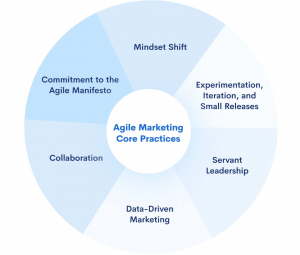Agile is one of the hottest buzzwords in today’s marketing landscape, but it is also the most misused one too. But that doesn’t stop there. With marketing becoming more advanced, customers becoming more tech-savvy, and online channels continuing to grow in proportion, businesses are trying to become agile. The only thing is that they do not know whether they’re doing it right. Especially small and mid-sized businesses who are either misunderstanding what Agile brings to the table or wrongly implementing it all together. If your business is in the B2B space, please review B2B marketing best practices for 2023.
What is Agile Marketing

The meaning of agile differs. However, according to McKinsey, agile means using data and analytics to continuously source promising opportunities or solutions to problems in real-time, deploying tests quickly, evaluating the results, and rapidly iterating. At scale, a high-functioning agile marketing organization can run hundreds of campaigns simultaneously and multiple new ideas every week.
Agile marketing, based on the Agile Marketing Principles and the Agile Manifesto, is a way to keep up with the speed and complexity of marketing and
- Focus on customer value and business outcomes overactivity and outputs
- Deliver value early and often over waiting for perfection
- Learn through experiments and data over opinions and conventions
- Cross-functional collaboration over silos and hierarchies
- Respond to change over following a static plan
What Agile Marketing Means for SMBs
However, for small and mid-sized businesses, such magnitude of campaigns would not exist as they do in multinational organizations.
Therefore in simple terms, agile marketing is an approach to marketing strategy through which an organization can boost its speed and flexibility by completing high priority ticket items in a much shorter period of time with a team of motivated marketers who collaborate and deliver value to the end customers.
Agile involves quick response to any change in the market, customer behavior, news or events while keeping the customer ahead of business outcomes always. It is centered on shorter planning cycles, transparent collaborations, iterations and reiterations, adaptability, and most of all, speed.
Why Agile Marketing?
Picture this – A fashion brand launching a new fall-winter collection wished to inform their audience through emailers. Its marketing team pulled out all the details i.e., a list of email IDs of customers, pictures of the latest collection. They forwarded the information to the content and graphic design teams, who would write the copy and design the email. It was then sent to the fashion designers for a short review to ensure that everything was in order and that the descriptions were accurate.
After a few weeks, once they were free, the fashion designers checked and shared it with the marketing team, who passed it to the VP of Marketing for approval and then forwarded the complete line item to the legal team, who authorized the entire piece a week later. It took four and a half weeks for an emailer to be ready to send to clients’ inboxes. What next? The competitor already launched their fall-winter collection a couple of weeks ahead.
Time is of the essence and if you are an SMB, you would understand the value of it. Imagine if you plan on running multiple such campaigns side by side for your business. This is where Agile marketing comes into the picture.
An agile approach to marketing
Accelerates processes – Agile helps augment marketing efforts in the shortest time possible. Marketers can chuck long-term plans that are rigid, for more flexible short-term experimental ones. It helps ascertain what’s working and what’s not and then accordingly take iterative measures for future campaigns.
Improves performance – People who form an Agile team are better at collaborating and working in a more efficient way than traditional teams. Since everyone is responsible for their own respective tasks that is an important link of the overall chain, team members are more responsible and productive, leading to greater teamwork and collaboration.
Delivers impact – Agile marketing is data-driven, given the fact that shorter experimentation leads to good data of what’s working and what’s not. It helps guide an Agile marketing team’s efforts towards the right direction through data-driven decision-making for the brand.
How to introduce Agile Methodology to Marketing?
It’s clear that Agile methodology is all about teamwork. It’s not a single person’s job and it’s not just about your processes. Rather it’s a mindset that binds them all together. There can be multiple possibilities for introducing an agile methodology to your marketing. But first, have a clear understanding of what you want an agile team to accomplish. Is there a new group of target customers you’d want to acquire, or do you want to improve an existing collection of client journeys?
- Decide on a plan of action and configure your data, analytics, and marketing technology infrastructure to support it.
- Assemble an Agile team – Find the right people for the job. They might be full-time employees in an in-house team, or they could be a remote talent team made up of industry experts. They must, however, be people with a diverse range of skills who can collaborate rapidly. If there are workers on the team, they must be relieved of their BAUs so that they may cooperate and focus on the topic at hand without being distracted by other office activities.
- Create your Agile Roadmap – make sure you have a clear set of goals and that all stakeholders are aware of the big-ticket goals and milestones. Then divide it down into weekly tasks that are manageable. Remember it’s marketing and not product delivery.
Use technology
When forming an Agile team, it’s critical to automate your marketing activities. Ascertain that you have the appropriate tools for collaboration, collaborative design and review, email marketing, and data collection and analysis. These are useful for keeping the team informed about the progress each member is making and taking corrective action if there are any red flags.
- Run Sprints, daily stand-ups – Since Agile implementation is cross-functional, it’s critical for everyone to be on the same page. Ensure daily sprints and stand-ups to assess the problem areas and reinvent. Do not forget to backtrack the project.
To keep the sprints on the track, you’ll need a few key team members with certain responsibilities, which include:
- A project manager who is in charge of the backlog and prioritizing of the team.
- A scrum master (also known as the Flow Master in a Kanban team) is the process owner.
- The execution team, also known as the squad that functions in a flat structure, is made up of cross-functional personnel.
Agile marketing could be the way forward but before you get right at it, begin by developing an agile mindset. Then incrementally layer agile methodologies into your processes and experiment before you adopt them.




